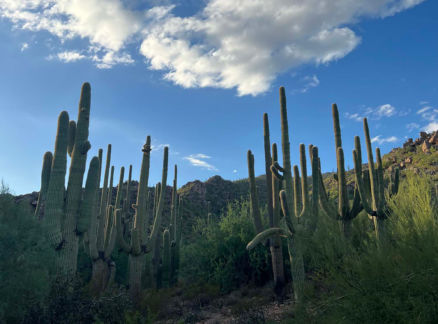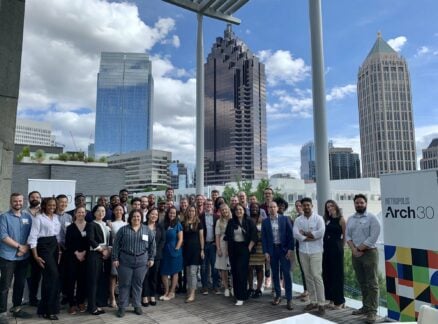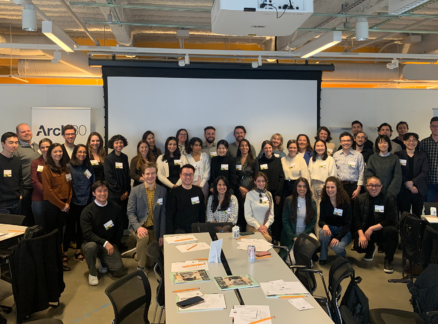December 1, 2011
Strange Bedfellows
An obscure zoning variance has allowed Occupy Wall Street protesters to camp out in a park owned by real estate developers.
First off: the loose-knit coalition of activists calling itself Occupy Wall Street is not the true occupier of that mythic thoroughfare. No, since 9/11 that role has been played by the New York City Police Department. For more than a decade, security measures have been in place around the New York Stock Exchange (NYSE), at the corner of Wall and Broad Streets (its famous columned facade actually faces Broad). The area has long been a proving ground for truck bomb–stopping bollards, from the much-lauded bronze boulders to the crazy illuminated turntable barriers (both designed by Rogers Marvel Architects) that swivel into position when threat levels spike.
In late October, the proximity of protesters camped out several blocks to the northwest prompted the NYPD to behave as though the empire of bean counters was being invaded by Mongol hordes. They ringed all noteworthy buildings or potential gathering spots with a maze of barricades. The steps of historic Federal Hall, where a giant George Washington statue stands, were off-limits, as was much of Broad Street itself. After 9/11, vehicular traffic was banned from the vicinity and the area was transformed into a pedestrian plaza, but at the moment you can’t set foot on the NYSE’s end of the street without passing through a police checkpoint and showing an Exchange ID.
While Occupy Wall Street has yet to offer up a coherent platform, what they’ve clearly demonstrated in months of camping out in Lower Manhattan is the peculiar elasticity of public space. Protest headquarters, for the moment, is a site a little over half an acre large called Zuccotti Park, which began life in 1968 as Liberty Plaza Park. It was created by the developers of the United States Steel building just across Liberty Street, in exchange for permission to build an extra half-million square feet of floor space. The protesters have been able to stay there, in large part, because the rules governing privately owned public spaces are different than those regulating public plazas. According to the city’s current standards, “By default, all privately owned public plazas are open to the public day and night, 24 hours.”
Zuccotti Park represents a type of space that has long been scorned in New York. The plazas were originally the product of a 1961 zoning law that allowed developers to build taller in exchange for their creating a purported public amenity. The conventional wisdom, at the time, was that New York was too densely built up and needed more open space. By the mid-1970s it was obvious that most of the plazas were useless and often inaccessible. The respected observer William H. Whyte conducted a study, the Street Life Project, which determined that with a couple of notable exceptions (the Seagram Building plaza was one), these so-called bonus plazas were a failure. Whyte concluded: “The city was being had. For the millions of dollars of extra space it was handing out to builders, it had every right to demand much better in return.” His criticisms eventually prompted a 1975 update of the zoning statute, which now assessed the quality of the plaza when handing out bonuses and encouraged niceties such as trees, benches, and tables.
Liberty Plaza was born bad. It emerged from the 1968 demolition of the sweetly eclectic 1908 Singer Tower—once the world’s tallest—and its replacement with the brawny U.S. Steel tower designed by Skidmore, Owings & Merrill. Now called One Liberty Plaza, the building was unusually cold looking, even for the 1970s, because its facade was dominated by U.S. Steel’s namesake product, rather than glass. The original plaza, paved in red granite, was described by the AIA Guide to New York City as “gloomy” and by the New York Times as “barren.” Eventually, U.S. Steel sold the tower. The plaza got buried in debris on 9/11, and the current owners, Brookfield Properties, hired Cooper, Robertson & Partners to give the plaza a much-needed facelift in 2006. The redesign added more than 53 trees, an angular axis symbolically connecting the World Trade Center site to the heart of the financial district, and a gangly red Mark di Suvero sculpture called Joie de Vivre. At the reopening, the plaza was renamed in honor of John E. Zuccotti, Brookfield’s chairman. When the occupiers arrived, they found a bonus plaza much more habitable than the dreary original.
Of course, when I initially heard that the anti–Wall Street demonstrators were camped out in Zuccotti Park, I had no idea where that was. It wasn’t until I happened to walk by one Sunday afternoon that I realized they had taken over what I still regarded as “U.S. Steel’s little patch of hell.” (Obviously the Cooper, Robertson redesign hadn’t registered in my consciousness.) My first thought was: it was brilliant that this nascent movement had figured out a way to exploit the quasi-public nature of the site.
At first glance, occupied Zuccotti Park looks like pure chaos, a favela on lower Broadway, where all activities—sleeping, eating, speechifying, silk-screening, drumming—take place outdoors, cheek by jowl. But I soon discovered that there was an ad hoc town-planning effort within Occupy Wall Street, one that displayed a real appreciation for this non-place. City University of New York (CUNY) geography professors Jessica Miller and Katie Gill, who consider themselves consultants rather than occupiers, marveled at how comfortable the plaza actually is. For example, the benches at Zuccotti aren’t divided into segments to prevent people from sleeping on them. “I think it was assumed no one would want to stay here because it’s near Wall Street,” Gill says. Still, the park wasn’t very welcoming before the mass campout began; according to Gill, “It was kind of a no-man’s-land. Now it’s everybody’s.”
The OWS planners wound up reinforcing architect Alexander Cooper’s diagonal axis with gaffer tape, trying desperately to maintain a clear path through the park. They moved the endless parade of speakers to a set of steps where their unamplified words have the best chance of being heard. They allotted more room to the “kitchen,” where donated food is served, and delineated a zone for sleeping. Mike Esperson, one of the movement’s most ardent planners, carried around a map that showed carefully color-coded spaces. He told me that he anticipated “uniform signage” for the encampment, tarps to harvest rainwater, and winterization. In his mind, Zuccotti Park was a permanent settlement that would improve over time. “What I’m really looking forward to is a culture of neatness and organization,” he told me.
The question I wanted answered was whether anyone in this supposedly leaderless movement had understood the advantages of setting up shop in a bonus plaza. As it happens, it’s more complicated to evict the occupiers from private property. Brookfield Properties would have to ask the police to do it, and so far the company has found it more expedient to let the occupiers stay. The only thing resembling an answer came from Daniel London, an urban historian who’s working on his doctorate at CUNY. He had helped the ad hoc planning effort by digging up the Cooper, Robertson plans for the plaza, so the group could examine the space they were working with. Asked whether the movement’s leaders deliberately chose Zuccotti Park for its nebulous legal status, London said, “I don’t think they fully understood the benefits of being here.”
One rainy afternoon, I attended a planning meeting held in privately owned public space at the base of the 55-story building at 60 Wall Street. The atrium, a flashy 1980s version of a Guastavino-tiled arcade, was the indoor equivalent of a bonus plaza. Inside were the usual guys in suits milling about, plus two sizeable ragtag circles of intensely earnest men and women in their twenties sitting on the floor discussing matters of governance: how to defuse an anticipated condemnation of the occupation from the local community board, how to silence the relentless drum circle that had installed itself at the west end of Zuccotti Park. Ironically, none of these Occupy Wall Streeters could set foot in the real public places up the street by the Stock Exchange. Just walking to the meeting from Zuccotti Park involved weaving through sidewalks intentionally choked by police barricades. But here, inside space long written off as a sop to developers, was a public sanctuary in which the revolution could proceed, unimpeded.





